The History Of Dodge RAM 250

The Dodge Ram is a full-size pickup truck from Chrysler LLC's Dodge brand. The name was first used in 1981 on the redesigned Ram and Power Ram, though it came from the hood ornament used on 1930s and '40s Dodge vehicles.
Dodge Ram trucks have been named Motor Trend magazine's Truck of the Year twice: the second-generation Ram won the award in 1994, and the third-generation Ram Heavy Duty won the award in 2003. The truck is in its fourth generation as of the 2009 model year.
The Ram is built at Saltillo Truck Assembly in Saltillo, Coahuila, Mexico; Saint Louis Assembly North in Fenton, Missouri, United States; and Warren Truck Assembly in Warren, Michigan, United States.
The first-generation Ram trucks, named for the Ram hood ornament that first graced Dodge cars in the 1930s, was introduced in 1981. Dodge kept the previous generation's model designations: "D" or Ram meant two wheel drive while the "W" or Power Ram meant four wheel drive. Like Ford, Dodge used 150 to indicate a half-ton truck, 250 for a three quarter-ton, and 350 for one-tons. Standard cab, "Club" extended cab, and crew cab versions were offered along with 6.5ft (2.0m) and 8ft (2.4m) bed lengths and "Utiline" and "Sweptline" styled boxes. Externally, the first-generation Rams were facelifted versions of the previous generation Dodge D-Series pickups introduced in 1972. The new model introduced larger wraparound tail lamps, single rectangular headlamps, and squared-off body lines. The interior was updated and included a newer style bench seat, and a completely new dashboard and instrument cluster. Available engines for these trucks were the 225cuin (3.7L) slant six, the 318cuin (5.2L) V8, and the 360cuin (5.9L) V8 with a variety of carburetors available for each engine. Among the other options offered on the Ram were front bumper guards, a sliding rear cab window, power locks & windows, and a plowing package for the 4-wheel drive version (referred to as the Sno Commander).
D100 models were added for 1984, replacing the previous "Miser" trim level available on the D150. The D100 model was a pickup for the average user who needed a pickup, but didn't use it all the time. A "Ram-Trac" shift-on-the-fly transfer case was added for 1985's Power Rams, and both the crew cab and Utiline flared bed were dropped for 1986. Also for 1986, a new crossbar grille and front end freshening appeared which was carried until the 1991 models came out. Engines were updated for the 1988 model year. The Slant-6 was dropped in favor of a 3.9 L fuel injected V6 with 25% more power. The 5.2 L engine also received electronic fuel injection in 1988. Because EFI was added, a computer was used to control ignition, fuel, and manage other areas of the engine and in some cases, the automatic transmission lockup function depending on the model. Inside the cab where a small compartment was once located on the dash, a new "message center" contained the check-engine light, brake warning light, and the warning light for the ABS if the truck was so equipped. Diagnostic fault codes were stored in the computer's memory, and cycling the ignition key three times would allow the computer to flash the trouble codes through the check-engine light for diagnosis of some problems.
For 1989, the 5.9 L V8 also received throttle body fuel injection for 20 hp (15 kW) more power. Rear ABS also became standard equipment. Additionally, Dodge introduced a new overdrive automatic transmission for reduced fuel consumption. This light-duty transmission was designated the A500, and was offered with the 3.9 L V6 and 5.2 L V8. An "O/ D Off" pushbutton switch to lock out the overdrive 4th gear was added to the message center. The A727 automatic saw continued use for heavy duty applications. The Cummins Turbo Diesel was also added to the engine lineup and for the first time, Dodge saw sales go up. The Cummins could be had with a heavier-duty version of the A727 automatic or a 5 speed manual transmission and was available on 250 and 350 pickups and chassis cabs.
The Ram 100 model designation was dropped and these models folded back into the "150" range for 1990 due to the introduction and sales success of the Dodge Dakota pickup. Additionally, the instrument cluster was slightly revised; the ammeter was replaced by a voltmeter while maintaining the 3-pod arrangement of the speedometer and gauges.
The grille was redesigned for 1991 but kept the large rectangular headlamps and crossbar appearance. The engines were substantially upgraded for 1992 (3.9L and 5.2L) and 1993 (5.9) with multi-port fuel injection, new manifolds and higher compression cylinder heads for noticeably higher output. These newly-revised engines were marketed under the "Magnum" name. A heavier-duty overdrive automatic transmission called the A518 was offered with the 5.2 L and 5.9 L engines. As part of Chrysler's overhaul of corporate transmission nomenclature, the A500 and A518 were redesignated 42RH and 46RH, respectively, in 1992. The initial "4" signified a 4-speed transmission, the second digit identified the transmission's relative torque capacity, the letter "R" in the third position denoted a rear-wheel drive transmission, and the final letter "H" signified hydraulic shift control. The 3-speed automatic remained available; the A727 was redesignated 36RH, and the A904, A998, and A999 became the 30RH, 31RH, and 32RH. During this time, Dodge reintroduced the Club Cab, which was equipped with fold-out jump seats. Although this added cab space, the jump seats were not very comfortable. Entry was made through the passenger or drivers doors as there were no rear doors for this configuration.
These trucks, though popular with fleets, sold poorly compared to the Ford F-Series and the General Motors C/ K Trucks, with just under 100,000 units sold most years of their production. Part of this was due to the dated cab and chassis design which had been in production since 1972. Additionally, the interior had been given few updates since 1981.
Engines
The Ram line was redesigned for 1994. The exterior styling was the result of design concepts by chief designer Phillip E. Payne, plus extensive customer research that revealed that full-sized pickup buyers were enamored of a strong exterior design that suggested the "look of a big rig truck". Dodge Truck Product Planners recognized that while some customers would not identify with the unique design, it would mandate instant recognition for the new Dodge full-sized pickup. It featured a big rig-looking front end and a large grille and was nothing like Ford or Chevy in design. Engine offerings continued over from the first-generation ram and were the 3.9 L V6, 5.2 L V8, 5.9 L V8, and 5.9 L I6 Cummins Turbo diesel. Added to the line up was a new 488 cubic inch 8.0L V10 engine designed as an alternative to those who wanted superior pulling power but didn't want a diesel. The new V10 and Cummins Turbo diesel could only be had in the 2500 and up trucks. Models were now the 1500 half-ton, 2500 three quarter-ton, and 3500 dual rear wheel one-ton in both 2 and 4 wheel drive in 6 and 8-foot (1.8 x 2.4 m) boxes.
Dodge offered the 2500 series in two different gross-vehicle weight ratings for the first few years but this was dropped in the late 90s. The purpose of the light duty and heavy duty 2500 trucks were for the heavy duty 2500 to take the place of the discontinued one ton single rear wheel trucks.
Transmissions for the Ram were the lower geared A500/ 42RH-RE for light duty applications found behind the 3.9 L V6, the A518/ 46RH-RE for more heavy duty applications found behind the 5.2 L and 5.9 L V8 engines, and the A618/ 47RH-RE for heavy duty use behind the V10 and Cummins engines.
On the inside, special attention was paid to in-cab storage features, with a large glovebox, a center armrest storage area, and extra storage space behind the seat. The dash and gauge cluster were a far cry from the previous model Ram and was far more modern as well. A redesign of the dashboard and instrument cluster was made in 1998 along with the introduction of the quad cab, and rounded black plastic side-view mirrors replaced the previous rectangular design.
A natural gas engine debuted for 1995 but was not popular and was only used in fleet vehicles on a very limited production run. In 1998, Dodge introduced the "Quad Cab", which used smaller suicide doors in the back for a door opening. This was offered as an option on the extended cab for the model year. In mid year 1998, the redesigned Cummins Turbo Diesel was released, a 24 valve version, now controlled electronically and producing more power and torque.
In 1999 Dodge revised the front end for the Sport models with a restyled bumper, quad-beam clear-lens headlamps, and body-color grille.
The redesigned 1994 Ram was a sales success, with sales rocketing from 100,000 units in 1993 to 240,000 in 1994, 280,000 in 1995, and nearly 400,000 in 1996. Sales of this generation peaked at just over 400,000 in 1999 before declining against the redesigned Ford and GM trucks. By 2001 however, the Ram was below Ford and Chevy's sales.
While Dodge introduced a new Ram 1500 for 2002, the old second generation style Ram was still produced for the 2002 model year 2500 and 3500 trucks. It would be another year until the new third generation Ram took over Dodge's heavy duty truck market. Part of this delay was because of the new 5.7 L Hemi engine not being ready. The 5.9 L V8 was offered until the Hemi was ready for mass production.
Engines
The third-generation Ram debuted for 2002 on half-ton models and 2003 on the larger trucks. This was a major update including an all new frame, suspension, power trains, interiors, and sheet metal. It included a larger grille, and special models kept interest up as most competitors had adopted the Ram's separate-fender look. The four wheel drive light trucks (1500 series) lost their live axles in favor of an independent front suspension, but the 2500 and 3500 series retained the live axles for maximum longevity and durability. This body style draws heavily from the previous generation.
The redesigned trucks bolstered sales, with 400,000 sold in 2002 and nearly 450,000 sold in 2003, a new high point for the Ram name. At the same time, both Ford and GM trucks were increasing in sales from a 2001 peak over 850,000 to the 900,000 range. But the Ram's sales could not keep up with the eleventh-generation F-150 and the new Nissan Titan in 2004 and 2005, with 400,543 Rams sold that year. With the introduction of the new 2007 Tundra, styled and engineered similarly to the Ram, Dodge was forced to significantly increase the incentives to keep demand up for their vehicle.
2006 to 2008: Facelift
The 2006 Dodge Ram is an updated version of the previous generation. One notable addition is the Mega Cab, featuring a 6-foot (2m) cargo box and 20inches (510mm) of extra cab space, allowing seating for six with rear recliners. Also, a full screen mapping in-dash navigation system is now an option. The headlamps have been redesigned for better performance.
Another change for the 2006 model year was the replacement of the first version 5.7L (345cuin) Hemi V8 in half-ton models with the newer Multi-Displacement System Hemi V8 engine that is available in Chrysler and Dodge sedans. This engine features the same performance but has a cylinder-deactivating feature enabled under light loads to increase fuel economy by 3 MPG city and 4 MPG hwy. This new Hemi still delivers 345hp (257kW) and 375lb·ft (508N·m).
In 2007 a 3500 Chassis Cab model was introduced, with industry standard rear frame width and wiring to accommodate outfitters. In addition to the 5.7L (345cuin) HEMI V8, a Cummins ISB 6.7L (408cuin) diesel rated at 305hp (227kW) and 610lb·ft (827N·m) was also available.
For 2008, Dodge introduced two more Chassis Cab models, the 4500 and 5500. These are class 4 and 5 trucks with a Gross Weight of 16,500lb (7,500kg) and 19,500lb (8,800kg), respectively. Both trucks come equipped with a version of the Cummins ISB 6.7L (6690cc, 408cuin) diesel rated at 350hp (260kW) and 650lb·ft (881N·m). Sterling, who worked with Dodge in development, has their own version called the Sterling Bullet with a unique grille. Sterling is a division of Freightliner LLC which, like Dodge, was owned by the former DaimlerChrysler.
Engines
The fourth generation Dodge Ram was introduced at the 2008 North American International Auto Show in Detroit. This latest generation will be sold as the 2009 Dodge Ram 1500 starting in Fall 2008. A light-duty diesel version will be released after 2009 and a two-mode hybrid version will be released in the 2010 model year.
This latest version of the Ram features a number of major innovations and improvements as the timing of this full redesign puts Dodge against fresh versions of its main competitors in the Ford F-150, Chevrolet Silverado, GMC Sierra, and Toyota Tundra. As such, Chrysler LLC is attempting to keep the Ram competitive in the market through various developments 2009 model, developing a new four-door cab style offering, new suspension, a new hemi engine option, and a new storage system that allows secure storage inside the truck’s bed walls.
The 5.7L HEMI V8's output has been increased by 45hp (34kW) to 390hp (291kW) and 407lb·ft (552N·m), and fuel efficiency has been slightly increased by 4%. The 4.7L (287cuin) H.O. PowerTech V8 produces 310hp (231kW) and 330lb·ft (447N·m), and the 3.7L (226cuin) PowerTech V6 continues with 215hp (160kW) and 235lb·ft (319N·m). A coil spring rear suspension replaces the leaf-springs, a move to improve ride quality and handling. The payload capacities have not been negatively affected despite the massive change in suspension. The Mega Cab option will be deleted, at least on the 1500 series, replaced by a true four door cab. The 2009 Dodge Ram has also received a 5-star U.S government crash test rating, the highest rating in the program.[citation needed]
Special Rams
In addition to factory equipment and appearance packages, the Ram pickup has also been offered at times with dealer-installed packages.
- SRT-10 - This is a regular or quad-cab body with the Dodge Viper's V10 engine, 22" wheels and Pirelli tires, lowered suspension, bucket seats, body modifications, and a spoiler. The 2004 version was available only in a single cab with a 6 speed manual transmission with a Hurst shifter. For 2005, Dodge released a Quad Cab version of the Viper V10 powered truck with the 48RE four speed automatic transmission from the 3500 Ram with the Cummins turbodiesel engine. In 2004, the truck won the Guinness record of "World's Fastest Production Pickup Truck" of 154.587 mph (247.3 km/ h) This record stood until bettered by the Australian Holden Special Vehicles Maloo R8 in May 2006. SRT-10 production ended on June 30, 2006.
- Power Wagon - This model, introduced for 2005, is an off-road focused version of the Ram. The name is drawn from Dodge's line of 4-wheel-drive trucks made from the early 1940s through the 1980s. It comes with the 5.7L (345cuin) Hemi engine, electronic locking differentials, electronic solenoid disconnecting sway bars, 33" off-road tires, handlebar, fender flares, "Hemi" nameplates instead of the standard Ram badging, and a 12,000 pound winch. This truck is built on the 2500 platform.
- Rumble Bee - The Rumble Bee package was a limited sport-truck version of the Ram. It was available only on regular cab/ short-box pickups and included lower body cladding, 20" wheels, a hood scoop, and a specially-trimmed interior including a serialized number plate. On the rear of the box was a stripe with a "Rumble Bee" emblem, similar to that of the Super Bee. All Rumble Bees were either black with yellow trim or yellow with black trim.
- HemiSport - The HemiSport Edition was the Quad Cab version of the Rumble Bee, and was introduced in 2004. It was available in black, red or silver, and with either rear-wheel drive or four-wheel drive. It was equipped similarly to the Rumble Bee, but without the number plaque. The HemiSport was discontinued for 2006.
- Daytona - Introduced for 2005, the Ram Daytona is a new sport-truck edition of the Ram. It is available in Regular or Quad-Cab styles and features lower body cladding, 20" chrome wheels, SRT-10 hood, Borla dual exhaust, serialized number plate, and a tall rear spoiler reminiscent of the 1969 Dodge Charger Daytona. The Daytonas have a black body stripe to match the rear spoiler and come in Silver or "Go Mango" paint with matching interior trim.
- Prospector - Throughout the 80s, this package was available for the Ram pickup. In the early 80s a special badge was affixed to the box side of the truck, but this was dropped in the mid 80s. Prospector was a package that usually included a different fuel tank, cloth seat and carpeting. In the later 1980s, a light package as well as the large 6x9 mirrors were added to the list of options. This trim package was carried on until the redesign in 1994.
- Sno Commander - known as the Sno-Fighter in the older D series trucks, the Sno-Commander came with 4-wheel-drive and the V8 engine as standard equipment. It included a snow plow, heavy duty cooling, a larger battery, and provisions on the engine to hook up hydraulics to work the plow as well as a cab controller. Early model Rams also had a badge on the box side. This package was discontinued after the redesign in 1994, but a similar package is offered through Chrysler called the Snow-Plow Prep package.
- Spirit Of '76 - A special package available in 1976 to celebrate America's Bicentennial. It came with a special decal that ran down the side of the truck and cloth or vinyl interior.
- NightRunner - 2000 of these were assembled from January 2006 to December 2006. The NightRunner trim includes 20-inch (510mm) black chrome rims, the 5.7L (345cuin) Hemi engine, dark shaded headlamps, NightRunner graphics, and the NightRunner logo on the speedometer.
- Limited Edition Indy Pace and SS/ T pkg - The Dodge Ram Indy Pace Truck was available in 1996. It included longitudinal stripes similar to those on the Dodge Viper along with an optional door sticker stating "Official Truck of the 80th Indianapolis 500." These trucks had a 5.9L (360cuin) engine with upgraded exhaust and 15hp (11kW) more power. These also included 17-inch (430mm) wheels with Goodyear Eagle II tires, size 275/ 60R-17. The SS/ T (Super Sport Truck) version was available from 1997-1998 and included all the same upgrades except the door sticker. The SS/ T also had "SS/ T" designed into the stripe on both the hood and tailgate. The Indy Trucks were available only in blue with white stripes. The SS/ Ts were available in white/ blue, red/ silver, black/ silver, and green/ silver. All include a specialty sticker on the inner door stating, "Built with pride in the U.S.A." as well as no tie downs on the tops of the bed sides.
- Dodge Ram R/ T - It is a concept with blue body, 22-inch forged wheels, SRT stripes, new front bumper with chin spoiler. It was unveiled in 2008 SEMA show.
Dodge announced a hybrid version of the Ram, dubbed the Contractor's Special, in 2003. However, the schedule for delivery slipped as Dodge backed away from the vehicle. The hybrid Ram was available only for fleet purchasers (if at all) and did not enter mass production. It offered an AC electrical outlet panel for running an entire job site worth of power tools, but the through-the-road method of balancing the gas engine and electric motor reportedly did not work as desired. Dodge has announced that it will use a hybrid transmission developed jointly with General Motors and BMW.
From Wikipedia, the free encyclopedia
More About Dodge RAM 250
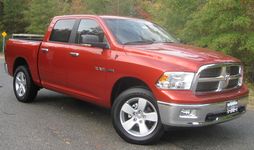
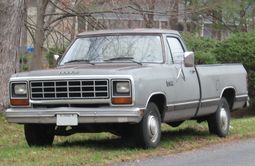
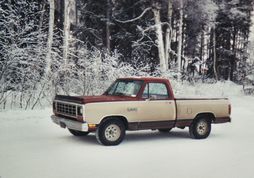
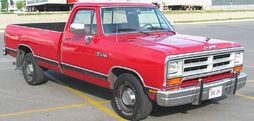
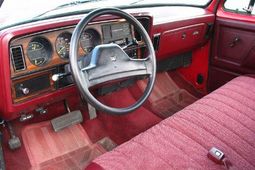
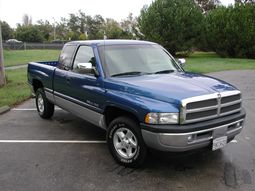

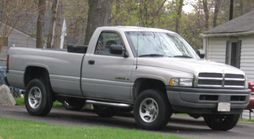
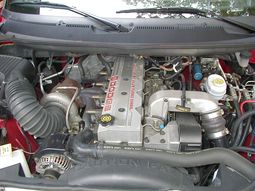
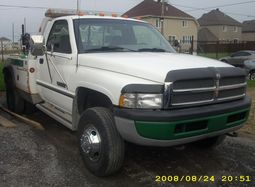
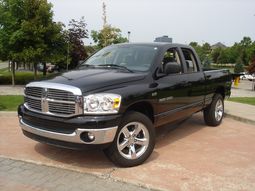
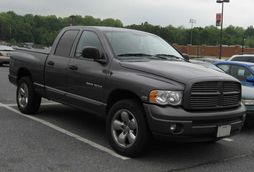
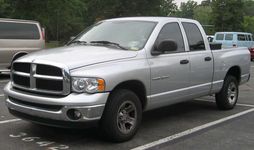
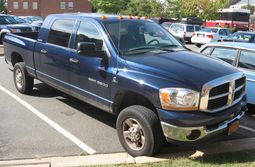
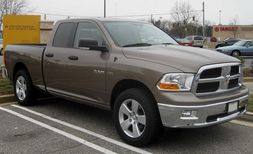
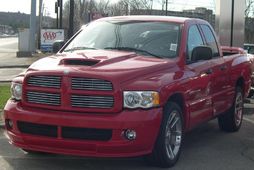
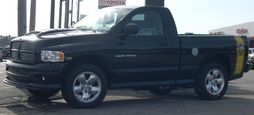
|